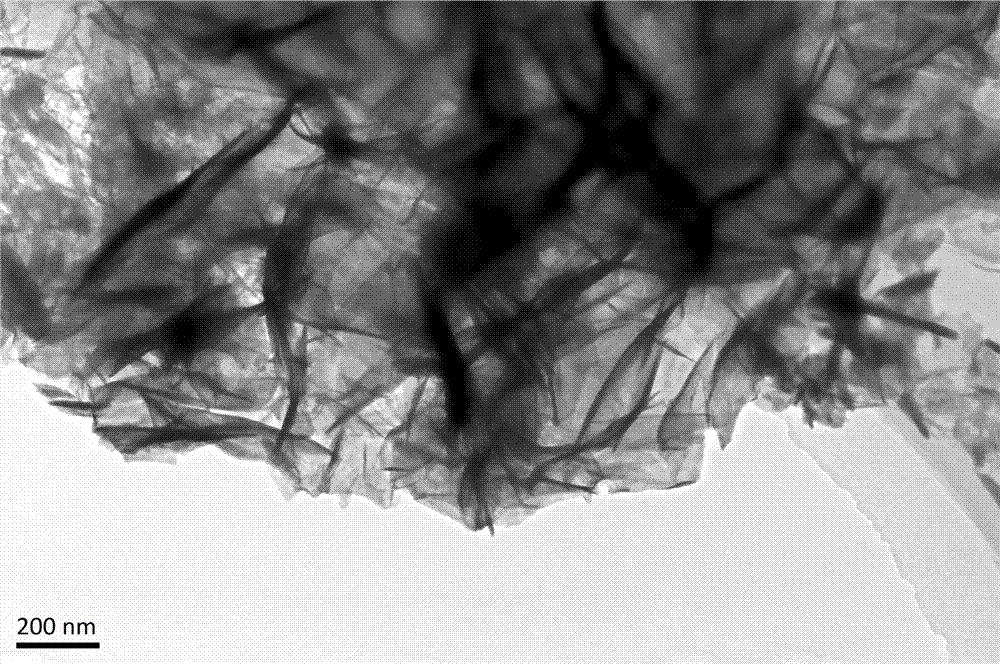Composite photocatalyst doped in heterojunction interface and preparation method
A composite light and heterojunction technology, applied in the direction of catalyst activation/preparation, chemical instruments and methods, physical/chemical process catalysts, etc., can solve problems such as unfavorable utilization of visible light, many by-products of carbon dioxide reduction, and difficulties in industrial production. Achieve the effect of good prospects for industrial application, enhanced recycling capacity, and large scale
- Summary
- Abstract
- Description
- Claims
- Application Information
AI Technical Summary
Problems solved by technology
Method used
Image
Examples
Embodiment 1
[0028] First, 10 g of melamine was heated to 700 °C at room temperature at 5 °C / min, and then cooled to room temperature at 20 °C / min for 5 h to prepare porous g-C. 3 N 4 Nanosheets. Then add g-C to the glycerol solution of bismuth chloride 3 N 4 The nanosheets were stirred and dispersed evenly, and then 10 mol / l sodium hydroxide was added dropwise to adjust the pH of the solution to 9. The precipitate was washed with water, centrifuged and dried. Heterojunction interfacially doped Bi 12 o 17 Cl 2 / g -C 3 N 4 composite photocatalyst.
[0029] The methane conversion rate reaches 323μmol / g / h.
Embodiment 2
[0031] First, 5 g urea and 10 g thiourea were heated at room temperature to 800 °C at 8 °C / min, and then cooled to room temperature at 30 °C / min for 6 h to prepare porous g-C. 3 N 4 Nanosheets. Then add g-C to the ethylene glycol solution of bismuth nitrate 3 N 4 The nanosheets were stirred and dispersed evenly, and then 3 mol / l ammonia water was added dropwise to adjust the pH of the solution to 10. The precipitate was washed with water, centrifuged and dried. Heterojunction interfacially doped Bi 12 o 17 Cl 2 / g -C 3 N 4 composite photocatalyst.
[0032] The methane conversion rate reaches 516μmol / g / h.
Embodiment 3
[0034] First, 150 g melamine and 50 g urea were heated to 600 °C at room temperature at 8 °C / min, and then cooled to room temperature at 5 °C / min for 3 h to prepare porous g-C. 3 N 4 Nanosheets. Then add g-C to the glycerol solution of bismuth carbonate 3 N 4 The nanosheets were stirred and dispersed evenly, and then 10 mol / l potassium hydroxide was added dropwise to adjust the pH of the solution to 12. The precipitate was washed with water, centrifuged and dried. Heterojunction interface-doped Bi 12 o 17 Cl 2 / g -C 3 N 4 composite photocatalyst.
[0035] The methane conversion rate reaches 364μmol / g / h.
PUM
 Login to View More
Login to View More Abstract
Description
Claims
Application Information
 Login to View More
Login to View More - R&D
- Intellectual Property
- Life Sciences
- Materials
- Tech Scout
- Unparalleled Data Quality
- Higher Quality Content
- 60% Fewer Hallucinations
Browse by: Latest US Patents, China's latest patents, Technical Efficacy Thesaurus, Application Domain, Technology Topic, Popular Technical Reports.
© 2025 PatSnap. All rights reserved.Legal|Privacy policy|Modern Slavery Act Transparency Statement|Sitemap|About US| Contact US: help@patsnap.com

